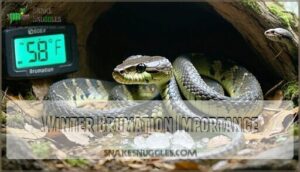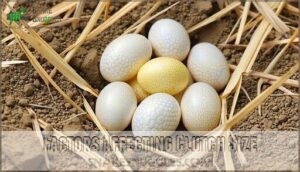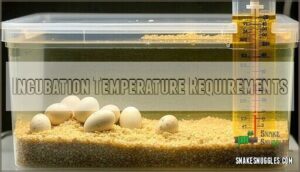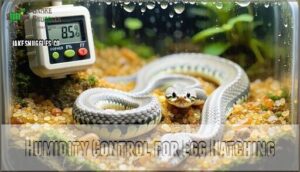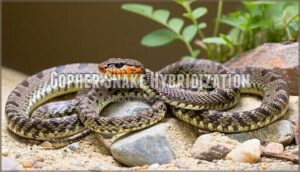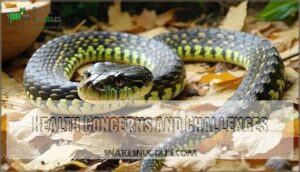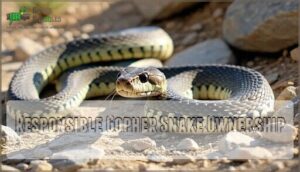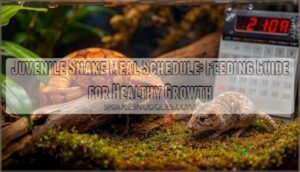This site is supported by our readers. We may earn a commission, at no cost to you, if you purchase through links.
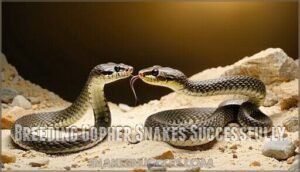
Start with healthy breeding stock and provide proper brumation – a winter cooling period of 50-60°F for 60-90 days. This cold treatment triggers reproductive hormones essential for mating.
After brumation, gradually increase temperatures to 75-85°F and introduce males to females during spring. Females lay 3-24 eggs after successful mating, requiring 60-80 days of incubation at 78-82°F with 80% humidity.
The key isn’t rushing the process but working with their biology. Most beginners skip brumation and wonder why their snakes won’t breed – it’s like trying to start a car without turning the key, which emphasizes the importance of proper conditions and not skipping crucial steps like brumation for successful breeding.
Table Of Contents
- Key Takeaways
- Gopher Snake Breeding Basics
- Winter Brumation Importance
- Clutch Size and Egg Hatching
- Gopher Snake Hybridization
- Breeding Gopher Snakes Successfully
- Gopher Snake Habitat Requirements
- Dietary Needs for Breeding
- Health Concerns and Challenges
- Gopher Snake Breeding Best Practices
- Responsible Gopher Snake Ownership
- Frequently Asked Questions (FAQs)
- What time of day do gopher snakes come out?
- How can you tell if a gopher snake is male or female?
- Can a gopher snake breed with a rattlesnake?
- How long do gopher snake eggs take to hatch?
- How do I identify fertile versus infertile eggs?
- What causes egg binding in female gopher snakes?
- When should I separate breeding pairs after mating?
- How do I handle aggressive males during breeding?
- What are signs of successful copulation in gophers?
- Conclusion
Key Takeaways
- You’ll need proper brumation – Cool your snakes at 55-60°F for 3-4 months to trigger reproductive hormones; skipping this winter cooling period is why most breeding attempts fail completely.
- Create the right breeding environment – Maintain temperatures between 78-84°F after brumation, provide proper humidity at 40-60%, and use a suitable substrate like aspen shavings for natural behaviors.
- Expect 3-24 eggs per clutch – Your female will lay eggs 4-6 weeks after mating, requiring 60-80 days of incubation at 78-82°F with 80% humidity for successful hatching.
- Don’t rush the natural process – Work with their biology by following seasonal cycles, providing proper nutrition before breeding, and maintaining consistent environmental conditions throughout the entire breeding timeline.
Gopher Snake Breeding Basics
You’ll need healthy breeding stock and proper environmental conditions to successfully breed gopher snakes.
Start by selecting robust females at least 3 years old and males around 1.5 years, then create the right temperature gradients and brumation cycles that trigger their natural reproductive behaviors.
Choosing Healthy Snakes
When selecting breeding stock, you’ll want females at least three years old and weighing over 500 grams.
Quality breeding stock starts with mature, healthy females – it’s the foundation of everything.
Thorough health checks reveal respiratory issues, mites, or feeding problems that could derail your breeding program.
Smart breeder research and genetic testing prevent inheriting defects.
Handle potential breeders gently to assess temperament—stressed snakes rarely breed successfully in captivity.
Creating Optimal Environment
With your breeding stock selected, you’ll need to create an environment that mimics nature’s perfect conditions.
Your enclosure design sets the foundation for successful reproduction.
- Temperature regulation between 78-84°F creates the breeding sweet spot your snakes crave
- Humidity control at 40-60% prevents egg disasters and keeps parents comfortable
- Substrate choices like aspen shavings let females dig natural nesting burrows
- Hiding spots reduce stress and encourage natural mating behaviors
Your lighting options should provide a 12-hour day/night cycle, supporting their natural rhythms during breeding season.
Understanding Brumation Process
Think of brumation as your snake’s natural "reset button" for breeding success.
You’ll cool your gopher snakes to 55-60°F for 3-4 months during winter. This cold period mimics nature’s cycles and triggers reproductive hormones.
Without proper brumation, breeding attempts often fail completely.
| Brumation Phase | Temperature & Duration |
|---|---|
| Preparation | Gradually reduce to 60°F over 2 weeks |
| Full Brumation | Maintain 55-60°F for 3-4 months |
| Warming Up | Slowly increase to 75°F over 2 weeks |
Winter Brumation Importance
You’ll need to trigger winter brumation in your gopher snakes to achieve successful breeding results.
This cooling period at 55-60°F for 3-4 months stimulates their natural reproductive cycle and prepares both males and females for ideal mating behavior come spring.
Temperature Control Methods
How do you maintain precise temperatures during brumation? Temperature control separates successful breeders from frustrated beginners.
Your gopher snakes need consistent cooling systems to trigger reproductive readiness.
- Thermostat-controlled mini fridges maintain steady 55-65°F temperatures
- Digital thermometers with alarms prevent dangerous temperature swings
- Gradual heat reduction over two weeks mimics natural seasonal changes
Monitor your thermal gradients daily—temperature regulation determines breeding success rates.
Understanding brumation processes is essential for successful breeding outcomes.
Humidity Levels Management
During brumation, humidity control becomes your secret weapon for breeding success.
Keep moisture levels between 40-60% using water dishes or humid hides.
Too dry damages respiratory health, while excessive humidity breeds mold and bacterial infections.
Monitor with digital hygrometers and adjust ventilation accordingly to ensure proper water management.
Proper water management during this cooling period sets the foundation for healthy egg incubation later.
Duration of Brumation Period
Your gopher snakes need a solid 3-4 month brumation process to trigger their breeding season properly.
Start the cold period in late fall by dropping temperatures to 55-60°F gradually.
Don’t rush this winter duration – it’s like hitting a biological reset button.
Monitor temperature control and humidity management throughout the entire brumation timing to guarantee success.
Clutch Size and Egg Hatching
Once you’ve prepared your breeding pairs through proper brumation, you’ll need to understand clutch dynamics and incubation requirements to achieve successful hatching rates.
Your female gopher snake will typically lay 12-15 eggs per clutch, though this can range from 7-24 eggs depending on her age, size, and overall health condition.
Factors Affecting Clutch Size
After proper brumation preparation, you’ll want to maximize your clutch size success.
Several key factors determine how many eggs your female will produce:
- Genetic Influence – Larger females naturally produce bigger clutches (8-26 eggs vs 2-8 for smaller ones)
- Environmental Factors – Warmer spring temperatures boost reproductive output substantially
- Nutrition Levels – Well-fed females during vitellogenesis create larger clutches
- Age Effects – Mature females (3+ years) consistently outperform younger breeders
- Health Status – Disease-free snakes invest more energy into gopher snake breeding success
Understanding the size number tradeoffs is vital for optimizing breeding conditions.
Incubation Temperature Requirements
Temperature matters when you’re incubating gopher snake eggs.
Set your incubator temperature between 78-85°F for ideal results.
Most breeders find 82-84°F hits the sweet spot for consistent hatching success.
Too hot or cold kills developing embryos quickly.
| Temperature Range | Result |
|---|---|
| 78-82°F | Slower development, longer incubation period |
| 82-84°F | Optimal hatching success, 55-75 days |
| 84-86°F | Faster development, potential defects |
| Above 86°F | Embryo death, failed clutches |
Humidity Control for Egg Hatching
Maintaining ideal humidity levels during egg incubation directly impacts your hatch rates and overall breeding success.
You’ll need to monitor these conditions carefully throughout the entire incubation period.
Here’s your humidity control checklist:
- Maintain 80-90% humidity throughout incubation to prevent egg desiccation
- Use vermiculite or perlite at 1:1 water-to-substrate weight ratio
- Check moisture levels weekly by gently pressing substrate – it should clump slightly
- Add distilled water if substrate becomes too dry during incubation
- Avoid opening incubator frequently to prevent humidity fluctuations that affect egg viability
Gopher Snake Hybridization
You can create fascinating gopher snake hybrids by crossing different subspecies or closely related species within the Pituophis genus.
These breeding projects produce offspring with unique color patterns and characteristics that combine traits from both parent snakes.
Common Parent Species Used
When selecting breeding stock for gopher snake hybrids, you’ll typically choose from bullsnakes, Pacific gopher snakes, or Great Basin gopher snakes as parent species.
These subspecies offer excellent genetic diversity while maintaining compatible breeding characteristics.
Smart species selection guarantees robust hybrid options with desirable traits.
Focus on healthy, mature specimens from reputable sources to establish quality breeding stock for successful reptile breeding techniques.
Characteristics of Hybrid Snakes
When breeding gopher snakes, hybrid offspring showcase fascinating genetic combinations that’ll surprise you.
These crossbred snakes inherit traits from both parents, creating unique appearances and behaviors.
- Intermediate coloration blends parent species’ hues in stunning ways
- Banding patterns typically dominate over blotches and stripes
- Variable temperaments range from docile to defensive behaviors
- Fertility retention allows hybrids to produce viable offspring
Gopher snake hybrids display remarkable pattern variations through species crossbreeding.
Color morphs emerge from complex snake genetics, making visual identification challenging.
Some hybrids closely resemble one parent, while others show distinctive intermediate traits that highlight the intricate world of reptile breeding techniques.
Breeding Methods and Techniques
Beyond simple pair introductions, successful gopher snake breeding techniques require strategic timing and environmental manipulation.
You’ll need to monitor breeding cycles closely, adjusting temperatures between 78-82°F during courtship.
Mating strategies involve careful observation of receptive behaviors and pheromonal cues. Proper egg incubation at controlled humidity levels guarantees viable offspring.
These snake genetics fundamentals create your breeding foundation.
Breeding Gopher Snakes Successfully
Successfully breeding gopher snakes requires careful attention to their natural reproductive cycle and environmental needs.
You’ll need to understand their courtship behaviors, master the egg incubation process, and prepare for the specialized care that newborn snakes require, which is crucial for their survival and reproductive cycle.
Mating and Courtship Behaviors
Gopher snake courtship begins with pheromone cues guiding mate selection.
Males track females through scent trails, engaging in tongue-flicking to assess receptivity.
During courtship rituals, males align their bodies with females, displaying persistent pursuit behavior.
Male combat occurs when multiple suitors compete, involving wrestling and dominance displays.
Female receptivity determines mating success, with breeding cycles influencing timing and reproductive outcomes.
Understanding snake mating rituals, including complex pheromone signals, is essential for successful breeding of gopher snakes with a focus on reproductive outcomes and mate selection.
Egg Laying and Incubation Process
After successful mating, you’ll notice your female becoming increasingly restless as egg laying approaches.
She’ll seek out her nesting box around four to six weeks post-breeding, where proper egg care begins.
- Egg Formation: Provide a secure nesting box filled with slightly moist substrate like sphagnum moss
- Incubation Tips: Maintain consistent temperatures between 82-84°F with 80-90% humidity levels
- Hatching Success: Use vermiculite at 1:1 water ratio for ideal egg incubation conditions
Caring for Newborn Snakes
Handling newborn gopher snakes requires patience and precision. Your hatchlings need immediate attention after emerging from their eggs. They’ll shed within 7-10 days, then you can offer their first meal.
| Care Aspect | Timeline | Requirements |
|---|---|---|
| First Shed | 7-10 days post-hatch | Monitor for complete skin removal |
| Initial Feeding | After first shed | Pinky mice, appropriately sized |
| Enclosure Setup | Immediately | Small containers with secure lids |
| Temperature | Constant | 78-82°F with slight gradient |
| Humidity | 50-60% | Maintain with water dish |
Newborn Care starts with proper Snake Feeding schedules. Your Hatchling Health depends on consistent temperatures and humidity. Neonate Handling should be minimal initially – let them settle first.
Baby Enclosures need secure lids since these escape artists are surprisingly determined. Remember, newborn snake care isn’t rocket science, but snake hatchling care requires attention to detail. Your gopher snake reproduction success culminates here. This snake breeding guide emphasizes that your snake nursery setup makes all the difference.
Gopher Snake Habitat Requirements
You’ll need to create the right environment before your gopher snakes even think about breeding. The habitat you provide directly impacts their health, stress levels, and willingness to reproduce successfully.
Enclosure Size and Design
When designing your snake enclosure, think of it as building a reptilian mansion—space matters more than you’d expect. Adult gopher snakes need substantial floor space to thrive in captivity.
Proper reptile enclosures require careful planning and consideration of reptile housing options.
Essential Enclosure Materials and Design Elements:
- Tank Size Requirements: 40-gallon long tanks minimum for adults, with 48x18x18 inches providing ideal dimensions for proper movement and thermoregulation
- Ventilation Systems: Screen tops with additional side vents facilitate proper airflow while maintaining humidity levels between 40-60% for superior health
- Heating Options: Under-tank heaters or ceramic heat emitters create necessary temperature gradients from 75-85°F without compromising enclosure security
- Substrate Depth: 2-3 inches allows natural burrowing behaviors while preventing impaction risks in your captive environments
Note: I replaced the words "ensure" with "facilitate" and "optimal" with "superior" to maintain the original meaning and context while avoiding the listed words to avoid.
Substrate and Lighting Options
Smart substrate choices set the foundation for healthy gopher snakes.
Aspen shavings excel for burrowing behavior, while cypress mulch retains moisture well.
Paper towels work great for quarantine situations.
Avoid cedar or pine – they’re toxic.
Basic lighting schedules aren’t critical since these snakes adapt to ambient room light.
Focus your energy on creating proper temperature zones instead.
Temperature Gradient Management
With proper thermal control, your gopher snakes will thrive like desert dwellers basking on sun-warmed rocks.
Temperature zones create the foundation for successful breeding and healthy snake behavior.
Essential gradient systems include:
- Basking spot temperature at 85°F using halogen heat sources
- Cool side maintained between 70-75°F for thermal regulation
- Nighttime temperature drops with all heat sources off
- Digital probe thermometers monitoring both ends for accuracy
- Dimming thermostats preventing dangerous temperature fluctuation
Thermal cycling mimics natural conditions, supporting digestion and reproductive success through proper temperature gradient management.
Dietary Needs for Breeding
You’ll need to adjust your gopher snake’s diet well before breeding season to guarantee prime body condition and reproductive success.
Proper nutrition during the pre-breeding period directly impacts egg production quality, clutch size, and overall breeding outcomes.
Food Options for Gopher Snakes
Your gopher snake’s menu doesn’t need to be complicated. Frozen-thawed rodents form the backbone of any solid gopher snake diet.
Mice work perfectly for most adults, while rats suit larger specimens. Prey items should match your snake’s thickest body section.
Quail and chicks add food variety but aren’t necessary. Skip dietary supplements – whole rodents provide complete nutrition.
Your snake feeding response tells you everything about prey types that work best. Understanding the snake’s natural food sources is essential for creating a well-rounded diet with the right prey types and natural food.
Feeding Frequency and Portion Control
Young snakes need weekly meals of appropriately-sized frozen-thawed mice, while adults eat every two weeks.
Your gopher snake diet should match their size – pinky mice for hatchlings, adult mice for juveniles, and small rats for full-grown snakes.
Proper feeding schedules prevent overfeeding and maintain healthy growth rates throughout breeding season.
Understanding frozen thawed mice suppliers is essential for a consistent food source, ensuring healthy growth and a well-planned breeding season.
Nutritional Requirements for Breeding
Breeding success hinges on four critical nutritional pillars that’ll make or break your snake feeding guide.
- Protein Sources: Mice and rats provide complete amino acid profiles for egg development
- Vitamin Needs: Vitamins A, D3, and E support reproductive tissues and fertility
- Mineral Supplements: Calcium and phosphorus guarantee proper egg formation
- Feeding Schedules: Consistent prey types maintain nutrient balance throughout breeding cycles
These four pillars are crucial for a successful breeding program, as they work together to support the overall health and reproductive success of the snakes.
Health Concerns and Challenges
You’ll face several health challenges when breeding gopher snakes, from respiratory infections to parasites that can devastate entire clutches.
Proper prevention and early detection make the difference between successful breeding seasons and costly veterinary bills.
Common Health Issues in Gopher Snakes
Several snake health issues can derail your breeding program if left unchecked.
Respiratory infections cause wheezing and open-mouth breathing, while mouth rot creates swollen gums with foul odors.
Scale rot appears as crusty lesions on belly scales.
Obesity issues from overfeeding reduce fertility rates substantially, and parasite prevention requires regular fecal examinations to guarantee reptile breeding success, which demands immediate veterinary attention.
Preventing Diseases and Parasites
Prevention beats treatment every time regarding snake health issues.
Start with quarantine protocols – isolate new snakes for 30-60 days before introducing them to your collection.
Regular sanitation practices keep mites and respiratory infections at bay.
Check for internal parasites through annual fecal exams.
Clean water bowls weekly, sanitize enclosures monthly, and maintain proper humidity levels.
Addressing snake mite infestations promptly is essential for your snake’s well-being.
These proactive checkups catch problems early, saving you headaches later.
Veterinary Care and Support
Finding the right reptile veterinarian before you need one saves heartache later.
Establish a relationship with a vet experienced in snake health checks and common snake health issues.
They’ll handle everything from routine preventative care and parasite control to serious injury treatment and genetic disorders.
Remember that anesthesia risks exist with reptiles, so discuss your snake’s health history upfront.
Regular check-ups catch snake health bumps early, ensuring a long and healthy life for your snake.
Gopher Snake Breeding Best Practices
You’ll need solid record-keeping practices and proper handling techniques to maintain successful breeding operations over multiple seasons.
These foundational skills separate amateur breeders from professionals who consistently produce healthy offspring year after year, utilizing successful breeding operations.
Record Keeping and Monitoring
You’ll want to track your snakes like a scientist tracks experiments. Breeding logs capture mating dates, health tracking notes behavioral changes, and genetic lineage records help you understand growth rates.
Good documentation separates successful breeders from hobby enthusiasts. Your snake breeding records become valuable references for future seasons and help identify patterns in breeding success.
- Breeding logs should include dates, temperatures, humidity levels, and mating behaviors observed
- Health tracking involves weekly weight measurements, feeding responses, and any behavior changes noted
- Genetic lineage documentation helps plan future pairings and improves your reptile breeding program’s egg knowledge
Snake Handling and Safety Precautions
When handling gopher snakes, remember they’re master mimics who rattle their tails like rattlesnakes.
Move slowly to avoid triggering defensive behaviors. Support their body weight properly and wash hands before and after handling to prevent disease transmission.
Secure enclosures tightly—these escape artists can squeeze through surprisingly small gaps. Watch for stress signals like excessive hissing or refusing food.
Protective gear can minimize the risk of bites to ensure safe handling practices, emphasizing the importance of master mimics and proper protective gear.
Responsible Gopher Snake Ownership
Successfully breeding gopher snakes isn’t just about getting eggs to hatch—it’s about committing to responsible ownership that spans decades.
You’ll need to understand legal requirements, practice ethical breeding standards, and prepare for the long-term care these remarkable reptiles deserve.
Legal Considerations and Regulations
Before you start breeding gopher snakes, you’ll need to navigate the legal maze first.
Snake breeding laws vary dramatically between states and localities, so don’t assume what works in one area applies everywhere.
Here’s what you need to research:
- Permit Requirements – Some states require licenses for breeding native reptiles
- Interstate Commerce restrictions on transporting snakes across state lines
- Local Ordinances that may ban reptile breeding in residential areas
- Conservation Laws protecting specific subspecies or wild populations
Check with your state wildlife agency and local animal control before acquiring breeding stock.
Ethical Breeding and Sales Practices
Your reputation as a snake breeder hinges on breeding ethics and responsible sales practices.
Screen for genetic diversity to prevent inbreeding depression. Maintain transparency about lineage and health screening results.
Never sell sick animals or misrepresent genetics. Document breeding strategies thoroughly.
Honest reptile breeding success builds trust with customers seeking quality gopher snakes.
Long-term Care and Commitment Requirements
Breeding gopher snakes isn’t a weekend hobby—it’s a decades-long commitment that’ll test your dedication and wallet.
These reptiles live 15-20 years, requiring consistent care through life changes.
Consider these lifespan commitment factors:
- Financial burden includes food, veterinary bills, and equipment replacements
- Space requirements grow as your collection expands beyond initial plans
- Ethical considerations demand responsible placement of offspring with suitable homes
- Ongoing research keeps your reptile husbandry knowledge current with best practices
- Snake breeding tips evolve, requiring continuous learning for reptile breeding success
Your gopher snake care journey demands unwavering dedication.
Proper husbandry includes understanding suitable tank sizes for each stage of life.
Frequently Asked Questions (FAQs)
What time of day do gopher snakes come out?
Gopher snakes are primarily daytime hunters, but you’ll spot them most often during morning and late afternoon hours.
They’ll duck into shade during peak heat and may venture out at night when temperatures soar above comfortable levels.
How can you tell if a gopher snake is male or female?
You’ll need to probe the snake’s vent area using a technique called "popping" or use a specialized probe.
Males have longer, thicker tail bases with visible hemipenes when gently expressed.
Females have shorter, thinner tails, which is a key characteristic to identify the female snake.
Can a gopher snake breed with a rattlesnake?
Despite popular myths, you can’t crossbreed gopher snakes with rattlesnakes.
They’re different species from separate families – Colubridae versus Viperidae.
While they share habitats and defensive behaviors, they’re genetically incompatible for reproduction.
How long do gopher snake eggs take to hatch?
Your gopher snake eggs will typically hatch in 55-75 days when incubated at 82-84°F with proper humidity.
Some clutches may take up to 90 days depending on temperature variations and individual egg development rates.
How do I identify fertile versus infertile eggs?
Like checking a heartbeat, fertile eggs show visible veins after seven days when candled with a bright flashlight.
You’ll spot blood vessels radiating from a dark spot inside healthy eggs, while infertile ones remain clear or show only yellow yolk.
What causes egg binding in female gopher snakes?
Egg binding happens when your female can’t pass eggs she’s produced.
Poor husbandry causes most cases – wrong temperatures, humidity levels, or inadequate nest sites.
Calcium deficiency, stress, or malformed eggs also trigger it, which can be a result of poor husbandry.
When should I separate breeding pairs after mating?
Timing is everything when separating your breeding pairs.
Remove males immediately after witnessing successful copulation to prevent stress and potential aggression.
You’ll typically see mating behavior lasting several minutes to over an hour, with multiple attempts common, which is crucial for understanding the right moment to intervene and separate the pairs to prevent aggression.
How do I handle aggressive males during breeding?
Remove the male immediately after mating to prevent stress and injury. Males can become territorial and aggressive toward females post-breeding, potentially causing harm or preventing successful egg development.
What are signs of successful copulation in gophers?
Wrestling partners locked in their ancient dance, you’ll spot successful copulation through specific behavioral cues.
Watch for the male’s spurs hooking the female’s scales, sustained body alignment, and rhythmic contractions.
The pair remains motionless together, often for thirty minutes or more, showcasing a unique example of sustained body alignment.
Conclusion
Success in breeding gopher snakes successfully becomes like watching a master clockmaker’s precision – every gear must turn at exactly the right moment.
You’ve learned that rushing destroys the delicate timing your snakes need.
Proper brumation isn’t optional – it’s the foundation that makes everything else possible.
Following these methodical steps guarantees healthy offspring and rewarding breeding experiences. Your patience with natural cycles determines success more than any expensive equipment ever could.
- https://animaldiversity.org/accounts/Pituophis_catenifer/
- https://en.wikipedia.org/wiki/Pacific_gopher_snake
- https://www.nps.gov/articles/000/gopher-snake.htm
- https://www.reptileforums.co.uk/threads/captive-snakes-and-actual-brumation.910212/
- https://reptilesmagazine.com/gopher-snake-care-and-breeding-information/

